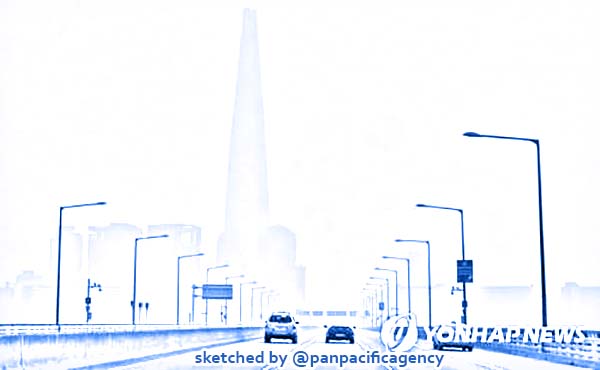Fine dust advisory issued nationwide in S. Korea

The sky over Seoul, seen from the Jamsil Grand Bridge on the Han River, is thick with fine dust on Jan. 14, 2019. (Yonhap). Sketched by the Pan Pacific Agency.
SEOUL, Oct 29, 2019, Yonhap. A fine dust advisory was issued in Seoul, Gyeonggi Province and many other parts of the country Tuesday, as local weather forecasters warn about a steady influx of yellow dust from abroad during the day, reported the Yonhap.
In Seoul, the advisory for PM 10, or fine dust particles smaller than 10 micrometers in diameter, was issued at 5 a.m., according to the Seoul metropolitan government.
The average PM 10 level in Seoul’s 25 administrative districts rose from 151 micrograms per cubic meter at 4 a.m. to 156 micrograms at 5 a.m. A fine dust advisory is issued when the PM 10 figure stays above 150 micrograms for longer than two hours.
The sky over Seoul’s Banpo Grand Bridge is thick with fine dust particles on Oct. 29, 2019. (Yonhap)
hide caption
As fine dust particles can cause various ailments and undermine the body’s immune system, municipal officials asked citizens with respiratory or cardiovascular problems, children and other vulnerable people to refrain from going outdoors. They also asked that citizens wear health masks when going outdoors or engaging in outdoor activities.
South Korea has been struggling to deal with fine dust particles both from home and blowing in from China, as well as yellow dust from Mongolia during the winter and spring seasons.
According to the National Institute of Environmental Research’s Air Quality Forecasting Center, Seoul’s PM 10 level fell to 119 micrograms as of 2 p.m., and the density of fine dust particles reached “bad” across the country throughout the day. The state-run agency classifies PM 10 levels between 81 micrograms and 150 as bad.
In Gyeonggi Province that surrounds Seoul, eight cities and counties, mostly in northern parts of the province, were placed under a fine dust alert as of 1 p.m., as their PM 10 figures surged above 150 micrograms per cubic meter.
Other metropolitan cities and provinces, including Jeju, Daegu, North Gyeongsang, North and South Chungcheong, Gwangju and South Jeolla, also issued a fine dust advisory in the afternoon, asking their residents to stay indoors to avoid the hazardous dust particles and drink sufficient water.
On Jeju Island, the PM 10 level surged to 212 micrograms per cubic meter as of 2 p.m., while Daegu recorded a PM 10 reading of 218 micrograms at the same hour.
The Air Quality Forecasting Center noted that yellow dust that originated from southern Mongolia and northeastern China between Sunday and Monday arrived on the Korean Peninsula early Tuesday morning. But the center forecast the fine dust levels are expected to return to normal nationwide Wednesday.
Meanwhile, the so-called PM 2.5 level of ultrafine dust, or the amount of particles smaller than 2.5 micrometers in diameter, remained normal in Seoul and almost all other parts of the country, excluding Busan, Daegu and the southeastern provinces of Gyeongsang.
As of 2 p.m., Seoul’s PM 2.5 stood at 18 micrograms per cubic meter, while Busan recorded 48 micrograms. South Korea’s authorities have classified levels of PM 2.5 above 35 micrograms per cubic meter as “bad” and above 75 micrograms as “very bad,” while the WHO recommends keeping levels below 25 micrograms.